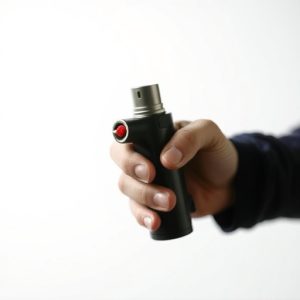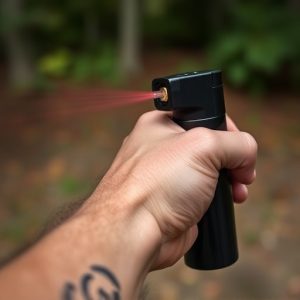Mastering Pepper Spray Defense: Safety, Treatment, & Product Choice
TL;DR:Exposure to pepper spray causes temporary but intense discomfort due to capsaicin, leading to…….
TL;DR:
Exposure to pepper spray causes temporary but intense discomfort due to capsaicin, leading to burning sensations, tears, breathing difficulties, and skin pain. Immediate treatment involves:
1. Move to safety and remove contaminated clothing gently.
2. Rinse affected areas with water for 15 minutes (eyes kept open).
3. Seek fresh air if inhaled; use a mask or cloth over mouth/nose.
4. Flush eyes with water for 15 minutes, seek medical help for severe pain or visual impairment.
5. Wash skin with mild soap and warm water, apply cool compress, consult healthcare for itching or blisters.
Early intervention and following manufacturer guidelines for pepper spray use are key to effective treatment and prevention of long-term damage.
Personal security is a growing concern, with pepper spray attacks posing a significant risk. This comprehensive guide delves into the world of personal defense, focusing on how to navigate and treat pepper spray exposure. From understanding the causes and symptoms to immediate response strategies and first aid techniques for eyes and skin, we explore effective ways to protect yourself. We also provide insights on choosing the right security product and offer preventive measures to avoid such attacks. Learn how to treat pepper spray exposure and stay safe with our expert advice.
- Understanding Pepper Spray Exposure: Causes and Symptoms
- Immediate Steps to Take After Contact with Pepper Spray
- First Aid Techniques for Eye and Skin Irritation
- Choosing the Right Personal Security Inflammatory Defense Product
- Preventive Measures: Tips for Avoiding Pepper Spray Attacks
Understanding Pepper Spray Exposure: Causes and Symptoms
Pepper spray, a common self-defense product, is designed to cause temporary disability and disorientation in potential attackers. However, exposure isn’t without consequences. Understanding how it affects the body is crucial for both its users and bystanders. When pepper spray comes into contact with mucous membranes, eyes, or skin, it triggers a reaction known as a inflammatory response. This leads to symptoms like burning sensations, tears, difficulty breathing, and pain. The severity can vary based on the concentration of capsaicin, the active ingredient, and the duration of exposure.
Treatment for pepper spray exposure is primarily about alleviating these symptoms. Immediately after exposure, flush eyes thoroughly with water for at least 15 minutes to dilute the chemical. If inhaled, move to fresh air and seek medical attention if breathing difficulties persist. For skin contact, wash the affected area gently with soap and water. In all cases, staying calm and seeking prompt assistance is vital. How to Treat Pepper Spray Exposure includes these simple steps, ensuring faster recovery and minimizing discomfort.
Immediate Steps to Take After Contact with Pepper Spray
After contact with pepper spray, immediate and proper treatment is crucial to minimize discomfort and speed up recovery. The first step is to get to a safe, open space away from the source of the spray. Remove any contaminated clothing or accessories, being careful not to rub the eyes or skin, as this can spread the irritant further. Rinse the affected areas with plenty of clean water for at least 15 minutes, ensuring thorough cleansing.
For eye irritation, hold the affected eyes open and continue rinsing. Seek medical attention if vision is impaired or if symptoms persist. Inhaled pepper spray should be treated by moving to fresh air immediately. If breathing is difficult, use a face mask or cover your mouth and nose with a clean cloth. Stay calm and seek emergency help if necessary, as respiratory distress may require professional assistance.
First Aid Techniques for Eye and Skin Irritation
In the event of exposure to pepper spray, knowing how to promptly treat eye and skin irritation is crucial for mitigating discomfort and potential long-term damage. If pepper spray comes into contact with your eyes, take a deep breath and gently flush them with clean water for at least 15 minutes. This helps to dilute the irritant and prevent further chemical reaction. Additionally, seek immediate medical attention if severe pain or visual impairment persists.
For skin irritation, remove any contaminated clothing and wash the affected area thoroughly with mild soap and warm water. Avoid using harsh chemicals or alcohol-based products that could exacerbate the situation. Apply a cool compress to soothe the skin and reduce swelling. If symptoms like itching or blisters develop, consult a healthcare professional for prescription-strength remedies to alleviate discomfort and prevent infection. Remember, early intervention is key in effectively managing how to treat pepper spray exposure.
Choosing the Right Personal Security Inflammatory Defense Product
Choosing the right personal security inflammatory defense product, like pepper spray, is crucial for effectively treating potential threats and protecting yourself in dangerous situations. When selecting a pepper spray, consider factors such as the spray range, duration of impact, and ease of use. Look for products with a proven track record of effectiveness against aggressive assailants, as well as those that include safety features to prevent accidental activation.
Additionally, understanding how to treat pepper spray exposure is essential. These defensive tools can cause temporary but intense discomfort, so having knowledge about the symptoms and remedies can make all the difference in mitigating the effects. Always follow safety guidelines provided by manufacturers, keep your device in a secure location, and practice using it regularly to ensure its reliability when needed most.
Preventive Measures: Tips for Avoiding Pepper Spray Attacks
Pepper spray attacks can be a frightening experience, but with the right precautions, you can significantly reduce your risk. Preventing an attack is always better than dealing with its aftermath. Start by being aware of your surroundings; notice any suspicious individuals or situations and trust your instincts. Keep your personal space clear, maintaining a safe distance from potential aggressors. Carrying a personal alarm or self-defense spray is also a smart strategy to deter attackers and provide crucial time for escape. Regularly attend self-defense classes to learn effective techniques and stay prepared.
If you find yourself exposed to pepper spray during an attack, knowing how to treat it promptly is essential. First, get to a safe, well-ventilated area immediately. Remove any contaminated clothing, especially around the face, eyes, and mouth. Rinse your affected areas with clean water for at least 15 minutes to dilute the pepper spray. Seek medical attention if breathing becomes difficult or vision is impaired. Having a supply kit ready with eye wipes, a change of clothes, and a reliable source of water can aid in faster recovery.
Knowing how to treat pepper spray exposure and prevent attacks is crucial for personal security. By understanding the causes and symptoms, taking immediate steps after contact, practicing proper first aid, and implementing preventive measures, you can effectively defend yourself in potential dangerous situations. When choosing a personal security inflammatory defense product, opt for reliable options that suit your needs. Remember, being prepared and informed could be a game-changer in navigating these challenging scenarios.


